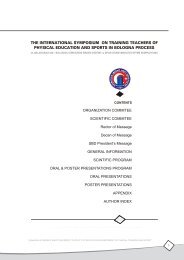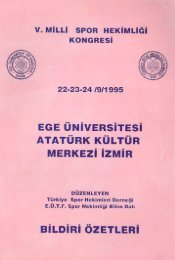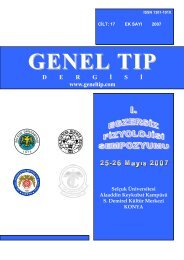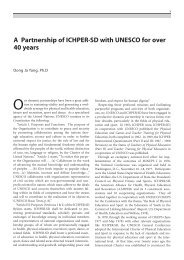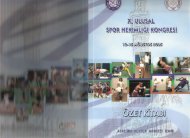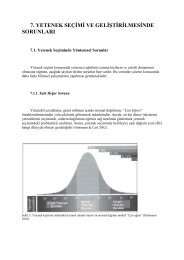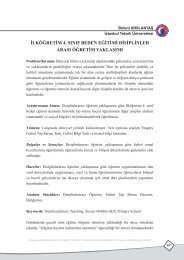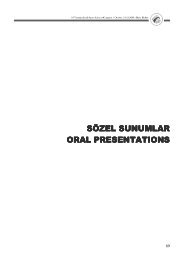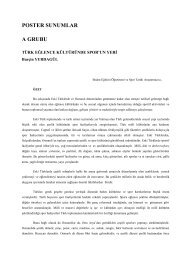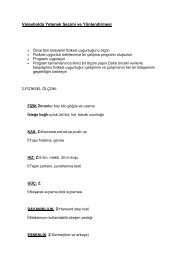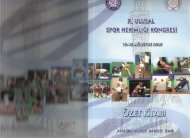KARDÄ°YORESPÄ°RATUVAR EGZERSÄ°Z TESTLERÄ° ... - Spor Bilim
KARDÄ°YORESPÄ°RATUVAR EGZERSÄ°Z TESTLERÄ° ... - Spor Bilim
KARDÄ°YORESPÄ°RATUVAR EGZERSÄ°Z TESTLERÄ° ... - Spor Bilim
Create successful ePaper yourself
Turn your PDF publications into a flip-book with our unique Google optimized e-Paper software.
7.ULUSLARARASI SPOR BİLİMLERİ KONGRESİ27-29 EKİM 2002KONGRE - PANELLERof ready access to methods of assessing skeletal maturity limits the use of this particular approach. Beunen etal. (1997) more recently reported a non-invasive anthropometric method in which adult stature for a 12.5 – 13.5year old boy could be predicted using an equation which incorporated current stature, sitting height, triceps andsubscapular skinfolds and chronological age.Regression fomulae may give a misleading impression of their precision in predictions. The standarderror of forecasting adult stature is equal to ± 4 cm. A limitation of the anthropometric formulae is due tochronological age not being a perfect marker of biological maturity. Therefore, an early onset of maturation canbestow an advantage in selection due to the greater than average body size. The late maturers are notnecessarily shorter as adults but may have missed opportunities for training at a critical time. Young playerswho mature early biologically may be given specialist coaching which late maturers are denied at the samechronological age. The late developers may emerge as potential future players only when growth is completed.Nevertheless, Claessens (1999) considered the prediction of adult stature to be important within the talentdetection and talent development processes in sport in general.There is also confounding effect of seasonal influences on eligibility for under-age competitions. A near12-months gap in age can make a huge difference in performance capability in youth competitions. Players withbirth dates early in the eligibility season tend to be pre-selected for elite squads, in both England and Sweden(Brewer et al., 1995). This advantage can persist into adult elite squads according to Richardson and Stratton(1999) who analysed the birth-dates of the England World Cup squads for the 1982-1998 campaigns. Theirconclusions were:i) there was an over-representation of England World Cup team players born early in the competition year(September to December);ii)the discrimination effect was greatest for goalkeepers, forwards and defenders;iii) talent identification and selection procedures should place more emphasis on talent and lessrelevance on physical attributes such as body size and strength.By having a birth date late in the competition year, boys may be disadvantaged by procedures withinsoccer sports systems. The ideal of matching children according to biological age is unrealistic (Borms, 1986),but there are opportunities to band players according to body size for training purposes.Body composition is more conducive to influence by environment and training than are linearanthropometric variables. The mean heritability coefficient for skinfold thicknesses is 55%, but there is a largestandard deviation. Coefficients for somatotypes range from 35-50%, the mean value for mesomorphy being42% (Bouchard and Lortie, 1984).Distinguishing between genetic and environmental determinants of biological and performance-relatedfunctions is an informative descriptive exercise. In contemporary genetics research a major effort is devoted totracing human gene sequences in their entirety. The Human Genome Project accelerated the internationaleffort to trace genes responsible for many biological phenomena and functions, including the location of genesthat are important in determining variation in human performance and in its physiological correlates. The panelof genes responsible for variability in human performance is the subject of a collaborative programme(GENATHLETE project) between North American and European research centres. The research was firstfocused on cardio-respiratory endurance and V O2max, factors that are linked with performance at top levelsoccer.4. Performance ProfilesThere were six different levels of sports involvement outlined in a pyramid model for assessment ofBrazilian children and youths aged 7 to 18 years. The tiers ranged from participants in physical educationclasses at the foot of the pyramid (Level 1) to those engaged in international competition at Level VI. Crosssectionalnorms were employed to assess developmental status and monitor change. These profilesincorporated anthropometric (height, weight, skinfolds), physiological ( V O2max) and performance (50-m sprint,40-s run, vertical jumps with and without arm assists, long jump, shuttle run) measures. Matsudo et al. (1987)372



